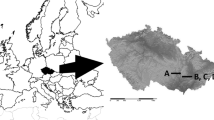Abstract
This study evaluated one semi-direct and three indirect methods for estimating leaf area index (LAI) by comparing these estimates with direct estimates derived from litter collection. The semi-direct method uses a thin metallic needle to count a number of contacts across fresh litter layers. One indirect method is based on the penetration of diffuse global radiation measured over the course of a day. The second indirect method uses the LAI-2000 plant canopy analyser (PCA) which measures diffuse light penetration from five different sky sectors simultaneously. The third indirect method uses the “Demon” portable light sensor to measure the penetration of direct beam sunlight at different zenith angles over the course of half a day. The Poisson model of gap frequency was applied to estimate plant area index (PAI) from observed transmittances using the second and third methods. Litter collection from 11 temperate decidous forests gave values of LAI ranging from 1.7 to 7.5. Estimates based on the needle method showed a significant linear relationship with LAI values obtained from litter collections but were systematically lower (by 6–37%). PAI estimates using all three indirect techniques (fixed light sensor system, LAI-2000 and Demon) showed a strong linear relationship with LAI derived from litter collection. Differences, averaged over all forest stands, between PAI estimates from each of the three indirect methods and LAI from litter collections were below 2%. If we consider that LAI=PAI−WAI (wood area index) then, all three indirect methods underestimated LAI by an additional factor close to the value of WAI. One reason could be a local clumping of architectural canopy components: in particular, the spatial dispositions of branchlets and leaves are not independent, leading to a non-random relationship between the distributions of these two canopy components.
Similar content being viewed by others
References
Bonhomme R, Chartier P (1972) The interpretation and automatic measurement of hemispherical photographs to obtain sunlit foliage area and gap frequency. Isr J Agric Res 22:53–61
Bouchon J, Faille A, Lemée G, Robin A-M, Schmitt A (1973) Notice sur les cartes des sols, du peuplement forestier et des groupements végétaux de la réserve biologique de la Tillaie en forêt de Fontainebleau. Laboratoire d'Ecologie Végétale, Université Paris-Sud, Orsay
Bréda N, Cochard H, Dreyer E, Granier A (1993) Water transfer in a mature oak stand (Quercus petraea): seasonal evolution and effects of a severe drought. Can J For Res 23:1136–1143
Bréda N, Granier A, Aussenac G (1995) Effects of thinning on soil and tree water relations, transpiration and growth in oak forest (Quercus petraea). Tree Physiol 15:295–306
Burton AJ, Pregitzer KS, Reed DD (1991) Leaf area and foliar biomass relationships in northern hardwood forests located along an 800 km acid deposition gradient. For Sci 37: 1011–1059
Campbell GS, Norman JM (1989) The description and measurement of plant canopy structure. In: Russel G, Marshall B, Jarvis PG (eds) Plant canopies: their growth, form and function. Cambridge University Press, Cambridge, pp 1–19
Chason JW, Baldocchi DD, Huston MA (1991) A comparison of direct and indirect methods for estimating forest canopy leaf area. Agric For Meteorol 57:107–128
Chen JM, Black TA (1991) Measuring leaf area index of plant canopies with branch architecture. Agric For Meteorol 57:1–12
Combres JC, Bonhomme R, Baldy C, Goillot C, Parcevaux S de (1970) Un pyranomètre linéaire destiné à la mesure du rayonnement sous couvert végétal. In: Hallaire M, Perrin de Brichambaut C, Goillot C (eds) Techniques d'études des facteurs physiques de la biosphère. Institut National de la Recherche Agronomique, Paris, pp 59–70
Ducrey M (1975) Utilisation des photographies hémisphériques pour le calcul de la perméabilité des couverts forestiers au rayonnement solaire. I Analyse théorique de l'interception. Ann Sci For 32:73–92
Ellsworth DS, Reich PB (1993) Canopy structure and vertical patterns of photosynthesis and related leaf traits in a deciduous forest. Oecologia 96:169–178
Fassnacht KS, Gower ST, Norman JM, McMurtrie RE (1994) A comparison of optical and indirect methods for estimating foliage surface area index in forests. Agric For Meteor 71: 183–207
Galoux A, Beneck P, Gietl G, Hager H, Kayser C, Kiese O, Knoerr KR, Murphy CE, Schnock, Sinclair TR (1981) Radiation, heat water and carbon dioxide balances. In: Reichle DE (ed) Dynamic properties of forest ecosystems. Cambridge University Press, New York, pp 87–205
Gower ST, Norman JM (1991) Rapid estimation of leaf area index in conifer and broad-leaf plantations. Ecology 72:1896–1900
Hutchinson BA, Baldocchi DD (1989) Forest meteorology. In: Johnson DW, Van Hook RI (eds) Analysis of biogeochemical cycling processes in Walker Branch watershed. Spinger, Berlin Heidelberg New York, pp 21–95
Hutchinson BA, Matt DR, McMillen RT, Gross LJ, Tajchman SJ, Norman JM (1986) The architecture of a deciduous forest canopy in eastern Tennessee, U.S.A. J Ecol 74:635–646
Jarvis PG, Leverenz JW (1983) Productivity of temperate, deciduous and evergreen forests. In: Lange OL, Nobel PS, Osmond CB, Ziegler H (eds) Ecosystem processes: mineral cycling, productivity and man's influence. (Encyclopaedia of plant physiology NS, vol 12D). Springer, Berlin Heidelberg New York, pp 233–280
Kruijt B (1989) Estimating canopy structure of an oak forest at several scales. Forestry 62:269–289
Lang ARG (1987) Simplified estimate of leaf area index from transmittance of the sun's beam. Agric For Meteorol 44: 179–186
Lang ARG, McMurtrie RE (1992) Total leaf areas of single trees of Eucalyptus grandis estimated from transmittances of the sun's beam. Agric For Meteorol 58:79–92
Lang ARG, Yuequin X (1986) Estimation of leaf area index from transmission of direct sunlight in discontinuous canopies. Agric For Meteorol 37:229–243
Lang ARG, Yuequin X, Norman JM (1985) Crop structure and the direct penetration of direct sunlight. Agric For Meteorol 35: 83–101
Lang ARG, McMurtrie RE, Benson ML (1991) Validity of leaf area indices of Pinus radiata forests estimated from transmittances of the sun's beam. Agric For Meteorol 57:157–170
Li-Cor (1992) LAI-2000 plant canopy analyser operating manual. Li-Cor, Lincoln
Monsi S, Saeki T (1953) Über den Lichtfaktor in den Pflanzengesellschaften und seine Bedeutung für die Stoffproduktion. Jpn J Bot 14:22–52
Nizinski J, Saugier B (1988) Mesures et modélisation de l'interception nette dans une futaie de chênes. Oecol Plant 9:311–329
Norman JM, Campbell GS (1989) Canopy structure. In: Pearcy RW, Ehleringer J, Mooney HA, Rundel PW (eds) Plant physiological ecology: field methods and instrumentation. Chapman and Hall, New York, pp 301–325
Perry SG, Fraser AB, Thomson DW, Norman JM (1988) Indirect sensing of plant canopy structure with simple radiation measurements. Agric For Meterorol 42:255–278
Rauner JL (1976) Deciduous forest. In: Monteith JL (ed) Vegetation and the atmosphere, vol 2: case studies. Academic Press, New York, pp 241–264
Ross J (1981) The radiation regime and architecture of plant stands. Junk, The Hague
Sabatier C (1989) Production de taillis de châtaignier (Castanea sativa Mill.) en relation avec les caractéristiques stationnelles. PhD Thesis, Université Paris-Sud
Schnock G (1983) Volume, biomasses, surface d'échange et autres caractéristiques dendrométriques des tiges de charme (Carpinus betulus L.). Acta Oecol Oecol Appl 4:325–342
Spitters CJT, Toussaint HAJM, Goudriaan J (1986) Separating the diffuse and direct component of global radiation and its implications for modelling canopy photosynthesis. Part I. Components of incoming radiation. Agric For Meteorol 38:217–229
Warren-Wilson J, Reeve JE (1959) Analysis of the spatial distribution of foliage by two-dimensional point quadrats. New Phytol 58:92–101
Welles JM (1990) Some indirect methods of estimating canopy structure. In: Goel NS, Norman JM (eds) Instrumentation for studying vegetation canopies for remote sensing in optical and thermal infrared bands (Remote sensing reviews). Harwood, London, pp 31–43
Welles JM, Norman JM (1991a) An instrument for indirect measurement of canopy architecture. Agron J 83:818–825
Welles JM, Norman JM (1991b) Photon transport in discontinuous canopies: a weighted random approach. In: Myneni RB, Ross J (eds) Photon-vegetation interactions: applications in optical remote sensing and plant ecology. Springer, Berlin Heidelberg New York, pp 389–414
Whittaker RH, Woodwell GM (1967) Surface area relations of woody plants and forest communities. Am J Bot 54:931–939
Author information
Authors and Affiliations
Rights and permissions
About this article
Cite this article
Dufrêne, E., Bréda, N. Estimation of deciduous forest leaf area index using direct and indirect methods. Oecologia 104, 156–162 (1995). https://doi.org/10.1007/BF00328580
Received:
Accepted:
Issue Date:
DOI: https://doi.org/10.1007/BF00328580




